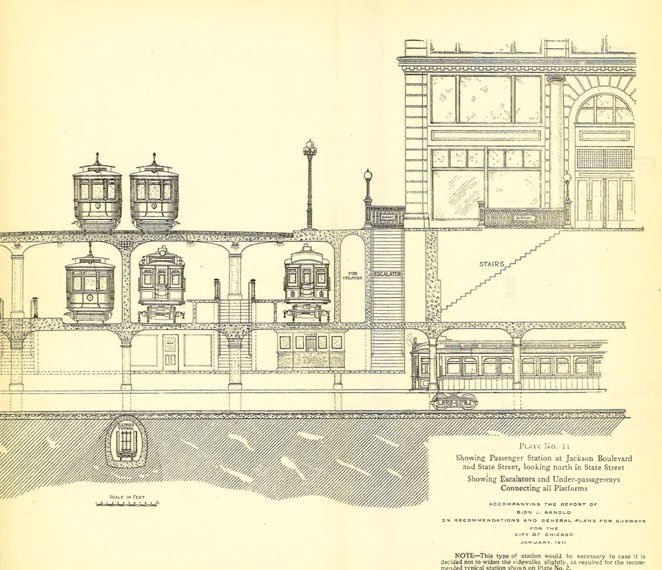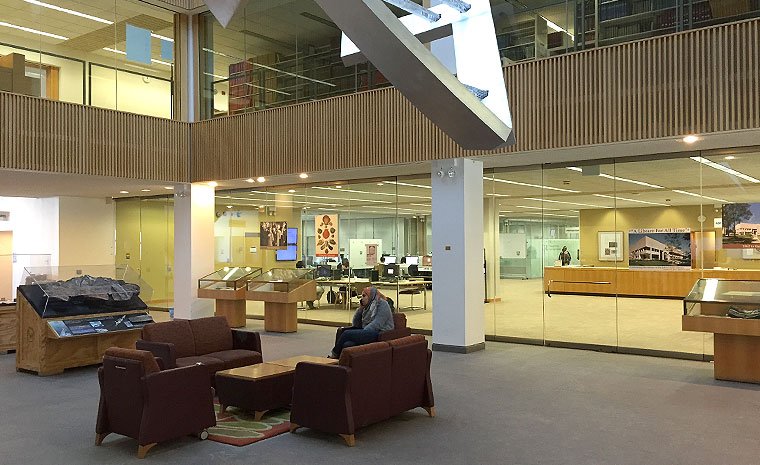Chicago's Subway Tunnels
River Tunnels
The low bridges crossing the Chicago River were frequently opened for
the passage of masted vessels, cutting off street traffic to the North
and West Sides. City officials began discussing tunnels under the river
as early as 1844. The 1,605-foot Washington Street tunnel opened January
1, 1869. North Side access was made easier with construction of the
LaSalle Street tunnel (1869–71), 2,000 feet long. The tunnels were a
valuable escape route during the fire of 1871, which quickly consumed
the wooden bridges. These first two tunnels served private vehicles and
pedestrians; they carried no horsecar lines. However, in the 1880s the
cable car companies took over the two tunnels, because cables could not
cross drawbridges, and in 1891–92 built a third street railway tunnel
just north of Van Buren Street, 1,514 feet long.
Although the tunnels
had been some 18 feet under the riverbed when built, reversal of the
Chicago River in 1900 exposed them. They were closed with the end of
cable car operation in 1906. Wider, deeper replacements were built
underneath the original tunnels and opened to electric streetcar service
in 1911–12. To avoid steep grades at either end, the new LaSalle Street
tunnel was built in dry dock, of steel plate, and lowered into a trench
in the riverbed.
The Van Buren Street tunnel was closed to regular
traffic in 1924. The LaSalle Street tunnel closed in 1939 to allow
subway construction, and the Washington Street tunnel was closed in
1954.
Subway
Beginning in 1938, federal financing from the Public Works
Administration facilitated construction on nine miles of rapid transit
subways. Route No. 1, under Clybourn Avenue, Division Street, and State
Street, and Route No. 2, under Milwaukee Avenue, Lake Street, and
Dearborn Street, were unfinished when the U.S. entered World War II. The
city was able to finish the State Street Subway by October 1943. The
Dearborn Subway opened in February 1951.
Contractors experienced with
sewer construction dug the subway through blue clay, about 43 feet
below street level. Station mezzanines were constructed by excavating
from street level and reconstructing the street on overhead steel
supports, a technique known as "cut-and-cover" construction. As had been
done earlier with the LaSalle Street streetcar tunnel under the Chicago
River, tubes constructed in dry dock were lowered into a trench in the
riverbed and connected to the State Street tunnels at both ends.
The
Dearborn Subway was extended in 1958 under the new Congress Parkway, and
the line to Logan Square was extended in 1970 using cut-and-cover
construction under Kimball Avenue to reach the Kennedy Expressway
extension.
Recommendations and General Plans for a Comprehensive Passenger Subway System for the City of Chicago, Made and Submitted to Honorable Fred A. Busse, Mayor, and Honorable Milton J. Foreman, Chairman, and the Members of the Committee on Local Transportation of the City Council of the City of Chicago, by Bion J. Arnold, January, 1911. Chicago (Ill.). City Council. Committee on Local Transportation. (1911). Crerar TF847 C4A7

